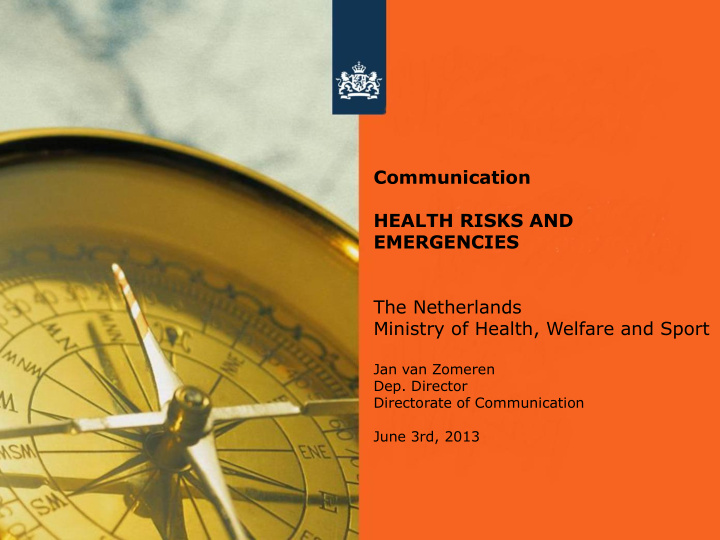



Communication Risicoperceptie en HEALTH RISKS AND crisiscommunicatie EMERGENCIES The Netherlands Ministry of Health, Welfare and Sport Verdiepingsbijeenkomst VWS Jan van Zomeren Dep. Director Maike Delfgaauw Directorate of Communication Nationaal Crisiscentrum 5 maart 2013 June 3rd, 2013
Fukushima Q(uery) Fever Recent Health Risks Schmallenberg A H1N1 Virus ESBL EHEC
Headlines • A changing world • Communication management structure • Manual in brief • Communication basics • Leasons learned
A changing world (in the Netherlands) • Mass production of meat and chicken • Use of antibiotics on a large scale • Changing climate; immigration of animals, plants, insects, diseases • CO2 emissions of beef, chicken and pork industries • Turning point: biological food, less meat • Turning point: more animal rights (living conditions)
A changing world (in the Netherlands) • Less public trust in authorities • Authorities/Government loose their monopoly on communication and information • Explosion of new technology and the use of mobile phone and social media • Media research versus Government transparency • Impact of perception of health emergencies, crisis, and hazards versus facts and figures
Strategies of communication on health risks Perception of risks • Disaster/Hazard: immediate (seasonal flue) versus creeping (HIV) • Media Attention: blog versus national tv news • Voluntary: own choice (eat meat) versus environment (meat industry) • Control: Me (healthy) versus He (obese) • Profits: direct (mobile phone) indirect (oil spills) • Knowledge (radiation, ESBL) • Trust in authorities/organisations ( nuclear plants)
Ministry Structure of Public Safety and Justice Ministry Commission of Outbreak of Health, Local, regional Management Hazard and national Welfare and Team administrators Sport National Institute for Public Health partners Local action
Communication team • Press officer • Strategic advisor/Team coordinator • Web editor • Information analist • Community manager/online specialist • Webcare hosts
Management of communication on health risks • Share information: facts and figures • Damage control: how to act • Address risks and measures perspective • Address emotions address stress, frustrations
Strategies of communication on health risks Taking responsibility and decisive action Swine Flue Attack and recover Q -fever Reticent, monitor EHEC
Communication basics on health risks T iming T rust (On behalf of Public interest and safety) T ransparent, clear for all Empathy when needed Factual and context, invalidate rumors Coordinated with relevant organisations Public spokesperson(s) Expert Pool Relevant channels and instruments Media monitoring, analysis Webcare
Communication on health risks Webcare: Twitter and health risk communication: 1. Source information 2. Combined information 3. Supporting information - Retweets - Recommendations - Re-sourcing
Communication on health risks Webcare: Twitter and health risk communication: Type of tweets: • observation/perception: public • information: authorities, public • sourcing: authorities, public • appeals: authorities, public • action: authorities, public
Communication on health risks Media Monitoring and analysis Monitoring: Continuously daily reports: - Finchline: online and social media (quantitative) - LexisNexis: all media (articles, blogs) - Coosto: social media (tweets) - Zoom media* (radio and tv items) * Dutch origin
Communication on health risks Media Monitoring and analysis Analysis: • Type of media • Type of information • Influentials/opponents • Geographic information • Tone of voice • Content/message
Communication on health risks Channels and instruments • One central website (facts, figures, context, how to act) • Facebook (Q and A) opt-in • Twitter (Refer, encourage, address) opt-in • YouTube (how to act, context, infographics) • SMS Alert (via Smartphone: how to act, refer) opt-in • Cell broadcasting (via Smartphone: how to act, refer) opt-out Live chats and videochats, advertising, expert meetings, posters and tv displays, leaflets
Communication on health risks Our leasons: 1. Risk assessments: keep it practical 2. Take political context into account 3. Understand the necessity of compromise 4. Convince authorities with strong arguments 5. Keep information clear, straight and transparent 6. Look for sponsors and support 7. Know your opponents 8. Make partnerships 9. Keep in touch:
Communication on health risks Keep in touch: • Don’t reassure the public • Admit uncertainties, share points of view • Respect the public opinion and emotion • Don’t make comparisons • Show the public what to do/how to act and renew the manuals once a year and organize a simulation/exercise twice a year !
Recommend
More recommend